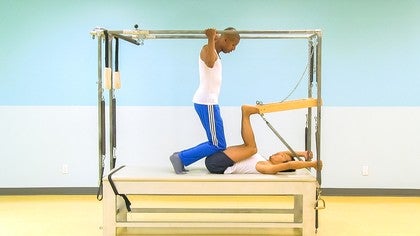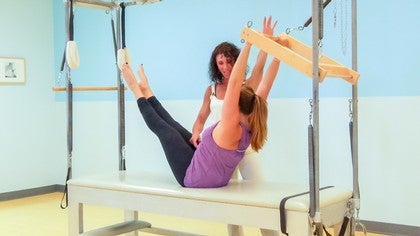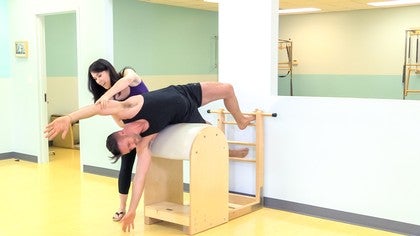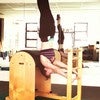Description
About This Video
Transcript
Read Full Transcript
Ramana was a genius with her hands on approach. It's really amazing. She didn't really think about it. Her hands just had almost like a brain of their own and they could just always go to where right where you needed them to be or where she needed them to be. And so the next exercise is called the bicycle. And I thought this would be a very good example of Romanos hands on approach.
Um, because not only does she use her hands, but she used her feet. She used her whole body, she used her hip. It's bring your leg into here. Tetsuo good. Now I'm going to have you bring your right shoulder forward a little bit. Lift the leg up, hip height. So what Ramana would do, she'd actually stand here and she'd use her body actually to be a little bit of a brace so that way people tend to roll backwards. So she kind of pushed there with her hip and then she'd hold onto the strap, kick the leg forward with a nice straight leg. So what she do, she'd actually use her hip to keep you still. Then she'd take her elbow, place it on the Sitz bone, her other hand, we'll go onto the foot and she given opposition.
So she was kind of like pulling forward and as she's doing that, she is lengthening the leg to give a maximum maximum stretch and the hamstring. Then from there, bend the knee. She'd do the same thing. She pushed forward with her body as she'd pull with her elbow and she'd pull the knee into the chest to also give length too, not just the hamstring, but also to the lower back. Then from there nigos back, she then switched her body and she'd use her leg. She bring one hand onto the hip to stabilize it. The other hand she would bring here and she'd give a nice, so as stretch in a stretch of the quadricep here. Now as I'm doing this tensile, pull your ribs in a little bit more zipper up through the core, and that also will give you a little bit more of a deep hip flexor stretch.
Then the most fun part is she'd pull the leg. Now as I pull you, pull your hip forward and she'd pull and what she's doing here, she's giving traction in the hip. And then let's do it again. Bring, keep the legs straight, Bryn leg forward and then stretch. Then bend the elbow and pool, bend the knee and then stretch and then extend the leg back and keep your hip really pulling forward. Topic forward more. There we go. One more time. Kicking front and she always just knew where to be and Ben, this is how she taught us to do it.
And now extend and stretch on the third one, which you do. She give a little circle, circle and one top. Hit forward more. Circle to circle three, reverse one. And each time I'm reversing, I'm actually giving a nice tug and pour the circle and then she'd give a couple of little extra tugs at the end there. Let's bring the leg home and then we reversed it. Go back and she'd pull Pauling giving traction of that hip and then bend the knee. There we go.
Near to ne new to shorter. There we go. And extend the leg. And again, swing the leg back, stretch top, hip forward, bend the knee, [inaudible] knee over knee. Need a shoulder and extend yet again, giving that long length and once again, swing the leg back. Ben, the knee, knee over knee, need a shoulder and extend the leg and stretch here. And then sometimes we'd actually end in a split, but considering we're doing hands on, we don't need to do that right now.
But when I learned this from Romana, which she would do is she'd actually, she'd say, we have this strap on and the leg was here. She'd bring her my hand on my hand here. Her hand would actually go on top of mine and she'd go feel with fist feel of attention that I'm pulling here. That's how much I want you to pull. And then she'd go, all right, bring your hip here, push a little bit more. She's like, do you feel that resistance there?
Now bend the knee and then she do the same thing. She's a push with your hip and she'd bring my hand here, my elbow here. She put her hand on top of mine and then she'd say, this is about how much you want to pull. She said, if you pour too much, it's going to be too much. But if you just give this much resistance, that's when you're going to get the maximum stretch. And then she'd do the same thing through each point. Here she's show us how much was too little or too much, and then she at the very end, she'd say, go for it. Alright, so the next exercise is actually more of a stretch and it's actually comes at the end of the tower.
And it's another example of Romanos hands on approach. And so, um, if you've done tower, you've probably have, are probably remember that it's very, very hard or probably felt it's very hard to get your whole back onto the mat. And essentially that's actually the goal is to actually have the whole back onto the mat. It sits bones forward and uh, uh, naval poured in. Now a lot of people can do that and you myself might remember it being very hard to do. So what Romana would do should actually should assist in it. And this is something she'd actually use her whole body form. She'd actually support herself with the bar.
And so that way she actually wasn't putting too much weight on the client. Everything was supported through the bars and she wouldn't just come down on the client and give all of her weight. She'd actually kind of pull down and forward to help lengthen because actually that's the goal is to get that back there. So instead of just pressing down, she meal slightly and then she'd pull back and down to help them get the lower back onto the mat. And now as she was doing that, she'd also tell them that it's a positive deal. So she wasn't doing all the work for them. What she would do, as she say, as I bring your my knees on you, I want you to try to think of your tailbone pooling down to the mat. So they were actually doing the action and so that way their body remembered it as well and she just gave a little bit of assistance and that was the tower with the assisted stretch at the end, the following exercise, it's rowing and I'm going to show an example of how Ramana would use a lot of her hands on approach. Amy, I'm gonna have you start rowing into the sternum night's rounded back and you're going to curve back. Now Ramani used to always talk about numbers, so she'd say, make a picture. This would be picture one.
Now open the arms out to the side. That's picture to now stay curved here. Press the arms straight back. Picture three, picture four is here. Now pull down in the Romano would lift our arms up. Then she say don't come back out too quickly. Let it lightly go.
Circle around. And then she give us a little stretch here and sometimes you get the voluma massage here. Then again, so two fist in, you're going to round the back curve backwards and cradle us here and then open the arms out to the side. And sometimes she put her fist here and create on say press even round over and she'd stand up here and then she lift arms up before she lift her arm. She actually kind of pulled downward first. Then she lifted up. Now sometimes all the way up to here. Then lightly let go, circle around stretch. There we go.
Yes, relaxing in there. Nice. And let's do one more. So two fisting, nice curve back, pressing curve back there. Open the arms out to the side, press back deep and over. Let's pull downward. And sometimes if they're a little tight and they couldn't keep their hands together, she'd have them open and she'd shake, shake, shake, shake, shake, shake, shake, shake, shake, shake, shake, shake, shake and then circle around. Good. And as you go, this is your dessert veith or some stretches that she would do with a lot of horror. I'm very stiff clients or elderly clients and sometimes she would do this here on the mat or sometimes she would sit them on a spine corrector in the lip.
Sometimes she would put pillows underneath them for them to sit on. And it really just depended on the client that she had in front of her. So I'm going to have you lift your arms up and we're going to start with circles. Sometimes she would do this after the spine stretch forward and she'd stretch when she pushed her knees into the back and around one and stretch. Good and stretch.
And let's reverse it around one and around two. Good. And one more time around three. Now what I'm gonna have you do, let's push your hands forward. There we go. So she's pushing her hands forward and I'm pushing in backwards against her. Now hands be on the base of the head and I'm going to give you a little stretch here and let's twist one direction. Then the other direction and twist, twist. Let's do one more and twist and also side to side.
And like I said, this was an exercise she would do more for the stiff individuals. So she'd never do this for someone who's very loose and one mom and two and two. I'm gonna give you one more extra stretch. Let's bring the arms out to the side again. And then what you're going to do is I'm going to open your chest here and you're going to pull your arms forward. Good.
[inaudible] so as you're pulling arms for it, I'm pulling you back. Very good. Now let's bring the arms down and bring your arms behind your back. Good. And I'm going to try to bring your hands together here. Good. And then I'm going to twist you one direction, twist you the other, and twist and twist. Let's do one more and twist and twist.
Now push out on me. There we go. Romanesco Poe, push and release. And I'm going to bring my hand and see how much further you went even just from there. Good. And now bring your arms up to the ceiling again and then I'm going to have you reached, grabbed my back. There we go. I'm gonna pull in on you. You can be a little stretch and then a nice pole. Good. Yeah.
And then arms down. And then just a little push here. Good. The following exercise is a stretch that Ramana would do for people who had, um, scoliosis. And so it's another example of her hands on approach. So we've established with Amy that this is her tighter side, so I'm going to stretch that side a little bit more and you're going to round over. This also is an example of how Romana would also work asymmetrically.
So I'm going to have you extend the arms straight up to the ceiling and a wrap through here. And you're going to over, we're going to stretch that tighter side. I'm going to bring this in here. I'm going to just give you a little bit of opposition here. Yeah. All right. Yeah, good. There we go. Now bring this hand behind the head. Great. And I'm just going to do a little bit more opposition here.
And sometimes she bring her hand here and say, breathe into my hand and exhale just to get that a stretch, Marcel, let's go back. Let's go actually to the side that it's not so tight. Okay. And I'm going to switch this barrel around for you.
And now I'm going to have you stand up and we're going to go back to the side this little tighter and I'm going to give you a little pillow here. Great. There we go. Ms Side. I'm actually going to give you a liberal ink, uh, how to wait there and then that extra weight there is going to give you a little extra stretch. There we go. You have that good. And take a deep breath in and exhale. And again, inhale and actually got already a lot looser on the side. One more time. Inhale and exhale.
There we go. And I'm going to take that weight from you and you can help yourself up there. And that is an example of both Romanos hands on approach, but also asymmetrical movement patterning.
Pilates Legacy Project: Romana Kryzanowska Methods
Comments
You need to be a subscriber to post a comment.
Please Log In or Create an Account to start your free trial.




























